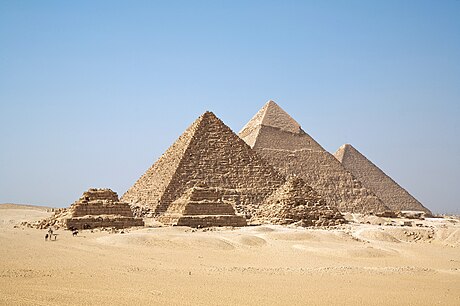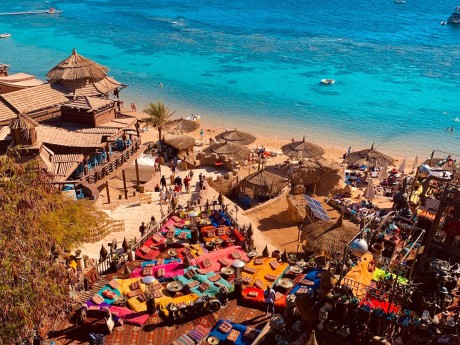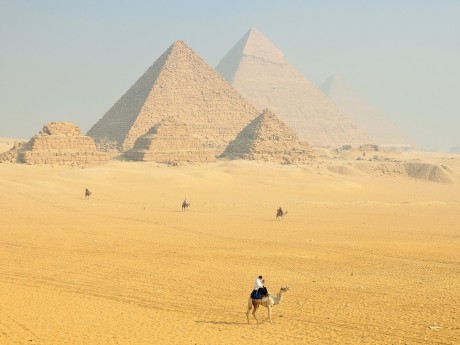Egypt: Cairo & Sharm El-Sheikh
Embark on an awe-inspiring expedition to Egypt, a land of unparalleled wonders and enchantment. In Cairo, marvel at the majestic pyramids and the enigmatic Sphinx, testaments to humanity's architectural brilliance. Immerse yourself in Egyptian culture by exploring bazaars and sampling traditional food. Enjoy panoramic views from the Cairo Tower or a relaxing Nile River cruise.
Read more
Embark on an awe-inspiring expedition to Egypt, a land of unparalleled wonders and enchantment. In Cairo, marvel at the majestic pyramids and the enigmatic Sphinx, testaments to humanity's architectural brilliance. Immerse yourself in Egyptian culture by exploring bazaars and sampling traditional food. Enjoy panoramic views from the Cairo Tower or a relaxing Nile River cruise. Finally, experience the pristine beaches of Sharm El-Sheikh, such as Naama Bay and Shark Bay, and dive into vibrant reefs and marine life. This trip, rich in culture, history, and magnificent sites, is one you won't want to miss. Waterviews strives to offer accommodation options within walking distance of water and/or in an area of touristic interest. Our prices include taxes (but excludes local tourist taxes). Customize your trip to your personal preferences with optional activities (hit the “Add Activities’’) or change hotels, etc. Contact us for customization at no extra cost at: Service@waterviewstravel.com
Destinations
- Cairo
- Sharm el-Sheikh
Itinerary
Cairo

Cairo (pronounced KY-roh<span style# "margin-left:1px">; Arabic: <span lang"ar">القاهرة al-Qāhirah) is the capital of Egypt and, with a total population of Greater Cairo metropolitan area in excess of 16 million people, one of the largest cities in both Africa and the Middle East (the regions which it conveniently straddles). It is also the 19th largest city in the world, and among the world's most densely populated cities.
On the Nile river, Cairo is famous for its own history, preserved in the fabulous medieval Islamic city and Coptic sites in Old Cairo — with historic Cairo inscribed on the UNESCO World Heritage list. The Egyptian Museum in the city centre is a must see, with its countless Ancient Egyptian artefacts, as is shopping at the Khan al-Khalili bazaar. No trip to Cairo would be complete without a visit to the Giza Pyramids and to the nearby Saqqara Pyramid Complex, where visitors will see Egypt's first step pyramid built by the architect Imhotep for the third dynasty pharaoh Djoser.
Though firmly attached to the past, Cairo is also home to a vibrant modern society. The Midan Tahrir area situated in downtown Cairo, built in the 19th century under the rule of Khedive Ismail, has strived to be a "Paris on the Nile". There also are a number of more modern suburbs including Ma'adi and Heliopolis, while Zamalek is a quiet area on Gezira Island, with upmarket shopping. Cairo is best in the fall or spring, when the weather isn't so hot. A felucca ride on the Nile is a good way to escape from the busy city, as is a visit to Al-Azhar Park.
Since the revolution in 2011 and the ongoing counter-revolution, tourists have fled Cairo to a large extent. This has created an opportunity for unique experiences of Cairo's and Egypt's cultural treasures without the crowds. Finding yourself alone inside a pyramid is now a real possibility. Prices are also lower.
Read more
Cairo (pronounced KY-roh<span style# "margin-left:1px">; Arabic: <span lang"ar">القاهرة al-Qāhirah) is the capital of Egypt and, with a total population of Greater Cairo metropolitan area in excess of 16 million people, one of the largest cities in both Africa and the Middle East (the regions which it conveniently straddles). It is also the 19th largest city in the world, and among the world's most densely populated cities.
On the Nile river, Cairo is famous for its own history, preserved in the fabulous medieval Islamic city and Coptic sites in Old Cairo — with historic Cairo inscribed on the UNESCO World Heritage list. The Egyptian Museum in the city centre is a must see, with its countless Ancient Egyptian artefacts, as is shopping at the Khan al-Khalili bazaar. No trip to Cairo would be complete without a visit to the Giza Pyramids and to the nearby Saqqara Pyramid Complex, where visitors will see Egypt's first step pyramid built by the architect Imhotep for the third dynasty pharaoh Djoser.
Though firmly attached to the past, Cairo is also home to a vibrant modern society. The Midan Tahrir area situated in downtown Cairo, built in the 19th century under the rule of Khedive Ismail, has strived to be a "Paris on the Nile". There also are a number of more modern suburbs including Ma'adi and Heliopolis, while Zamalek is a quiet area on Gezira Island, with upmarket shopping. Cairo is best in the fall or spring, when the weather isn't so hot. A felucca ride on the Nile is a good way to escape from the busy city, as is a visit to Al-Azhar Park.
Since the revolution in 2011 and the ongoing counter-revolution, tourists have fled Cairo to a large extent. This has created an opportunity for unique experiences of Cairo's and Egypt's cultural treasures without the crowds. Finding yourself alone inside a pyramid is now a real possibility. Prices are also lower.
Additional Information
Cairo is on the Nile, and has ancient origins in the vicinity of the Pharaonic city of Memphis. The city started to take its present form in 641 CE, when the Arab general Amr Ibn Al-Ase conquered Egypt for Islam and founded a new capital called Misr Al-Fustat, "the City of the Tents". (The legend is that Al-Ase, on the day he was leaving to conquer Alexandria, found two doves nesting in his tent. Not wanting to disturb them, he left the tent. Upon returning victorious, he called his soldiers to pitch their tents around his, and this became the site of the new city in what is now Old Cairo.) The name may have been a pun - Misr/Masr is the Arabic word for city, but it is also the Arabic name of the entire country of Egypt. The Tunisian Fatimid dynasty captured the city in 969 CE and founded a new city, Al-Qahira ("The Victorious") just north of Al-Fustat. Al-Qahira gave the city its English name, Cairo, but the locals still call it MàSr (مصر), which is also the Arabic name of the entire country of Egypt (similar to Mexico City in Mexico).
Climate
The best time to visit Cairo is during the winter from November to March, when daytime highs mostly stay below 26°C (79°F), with night time lows around 10°C (50°F) with occasional rain showers clearing the air, but still, you do not need an umbrella, even the rainiest months of the year rarely top 10 mm (0.4 in).
If visiting during winter, be aware that not all buildings are equipped with heaters, including some hotels and hostels. Visitors should always pack a few warm jumpers (sweaters) and a warm jacket for evening wear. In Cairo, in indoor buildings without air-conditioning, temperatures are about 15°C (59°F) in the coldest winter days and about 34°C (93°F) in the hottest summer days.
The brief spring from March to May can be pleasant as long as there are no sand storms, but summer temperatures, on the other hand, can reach a searing 38°C (100°F). In September and October, the period of late summer and early autumn, farmers burn rice husks to ash after sunset near Greater Cairo and this makes the air smokey.
Orientation
Today's Greater Cairo is a city with at least 17 million inhabitants, where skyscrapers and fast food restaurants nestle up to world heritage monuments. Cairo used to be the designated name of the city on the eastern bank of the Nile, and this is where you'll find both the modern Downtown, built under influence of French architecture, today the centre of commerce and popular life, as well as historical Islamic and Coptic sights.
Outside the core on the eastern bank, you'll find the modern, more affluent suburbs of Heliopolis and Nasr City near the airport, and Ma'adi to the south. In the middle of the Nile is the island of Gezira and Zamalek, where many embassies exist. On the western bank is lots of modern concrete and business, but also the great Giza pyramids and, further to the south, Memphis and Saqqara. The city might seem like a lot to handle, but give it a try, and you will find that it has a lot to offer for any traveller.
© Sourced from Wikivoyage
Sharm el-Sheikh

Located between the desert of the Sinai Peninsula and the Red Sea, Sharm el-Sheikh is one of Egypt's most popular holiday destinations. The resort town is known for its beautiful sandy beaches and its family-friendly atmosphere, making it the perfect destination for relaxed breaks, and is also home to a wide range of restaurants, cafes, bars and hotels. The nearby Ras Mohammed National Park is one of the top diving and snorkelling spots in the world, boasting breathtaking coral reefs, crystal-clear waters and exotic marine life.
Read more
Located between the desert of the Sinai Peninsula and the Red Sea, Sharm el-Sheikh is one of Egypt's most popular holiday destinations. The resort town is known for its beautiful sandy beaches and its family-friendly atmosphere, making it the perfect destination for relaxed breaks, and is also home to a wide range of restaurants, cafes, bars and hotels. The nearby Ras Mohammed National Park is one of the top diving and snorkelling spots in the world, boasting breathtaking coral reefs, crystal-clear waters and exotic marine life.
Additional Information
Sharm el-Sheikh is one of the most popular tourist destinations in the Arab world. But there are also some very good reasons to visit it if you are not the common tourist, who likes to lie on the beach all day. It is one of the finest diving spots in the world and a trip into the desert is an unforgettable adventure.
The Sinai Peninsula is a remote desert mountain range. The rocky mountains are parted from the deep-blue sea by a flat desert strip. This combination of desert and sea is an incredible sight and makes you believe you are on a different planet.
Sharm el-Sheikh used to be nothing but a small fishing village with about 100 Bedouin citizens. When Sinai was occupied by Israel in 1967, Sharm el-Sheikh started to develop as a tourist destination (like the rest of the peninsula). The Israelis evacuated Sinai between 1979 and 1982 following the signing of a peace agreement between the two countries. Since the 1980s, the Egyptians have been continuing the development of Sharm where the Israelis left off. Sharm's 100 grew into a bustling 10,000 population. There is now a nice promenade, a Hard Rock Cafe, one of the most modern hospitals in Egypt and so on.
Climate
The climate is very dry. Rainfall is very rare. The weather is very hot in summer days and moderately hot at summer nights. In winter, it is warm at days and has one of the warmest night temperatures in Egypt.
The most comfortable time to visit Sharm El-Sheikh are late summer and beginning of the fall. For example in September the air temperature is about 34 °C and water is about 29 °C.
Orientation
The Na'ama Bay part of the city is the center of nightlife and dining: most of Sharm's clubs, cafes, restaurants and shops are here. Na'ama Bay lies midway between Sharm Airport and Old City, nearly 10 minutes driving from each.
Microbuses can take you from downtown, but to reach Na’ama Bay from the airport, you will have to take a cab.
Sharm el Sheikh has grown into three distinct areas now, Nabq is a new area to the north of Na'ama, Old Market and Hadaba to the south of Na'amaa Bay.
© Sourced from Wikivoyage





